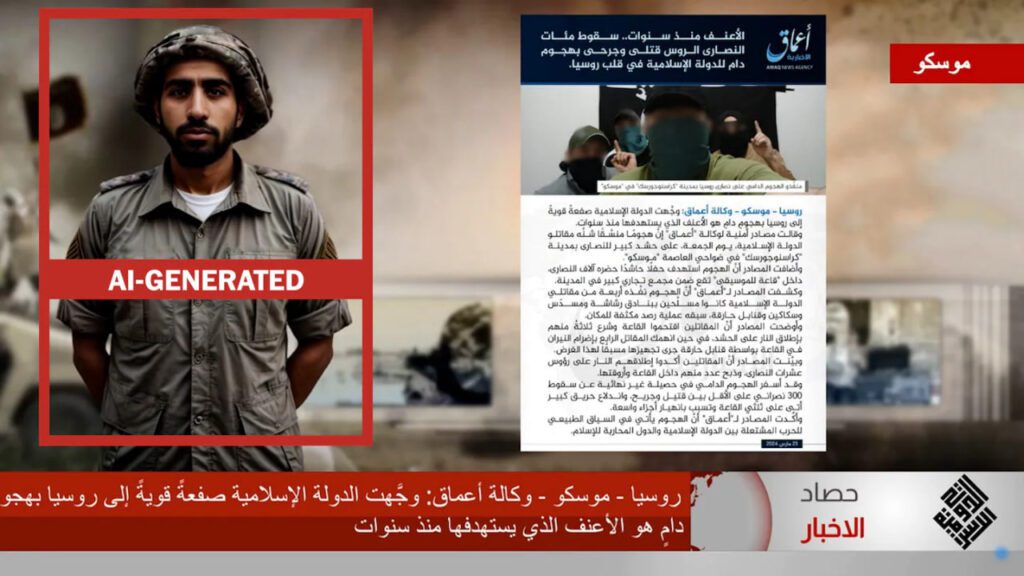Terrorists have begun to leverage artificial intelligence to produce content online. This is being done to offset the limited capacity of a highly reduced media production apparatus, but also acts as an attempt to bring new styles of content (such as translated video, or stylized infographics) to the modern reader, who may not be as versed in the intricacies of Salafi Jihadist prose. A prominent online foundation (Tech Against Terrorism) have archived over 5k individual pieces of content produced through artificial intelligence tools, and their adoption is increasingly being seen through IS and AQ supporters, as their accessibility and hysteria proliferates online. Our research indicates that this extends to Large Language Models (LLMs; such as GPTs) being used to produce speeches, editorials and insightful material, and Generative Adversarial Neural Networks (GANNs; such as diffusion techniques) being used to generate infographics, audio, video and synthetic faces. But as control of the narrative begins to shift from religious scholars to machines, questions are presented over the validity and purity of their message.

An example of where this balance was tested is the Hisad media group, which was seeking to leverage an animated presenter to interpret the ‘Caravan of Martyrs’ from the weekly IS Core ‘al-Naba’. The artificial intelligence model had produced a computerized Arabic male, with ‘barq’ (full beard) and ‘keffiyeh’ (traditional headdress), standing in front of the ‘al-Sawda’a’ (Black Standard IS flag) amongst stylized dust and explosions. To the right, sections of the text were superimposed, and interspersed with legacy combat images and footage from the affiliates. This style of content initially surfaced in March following the Crocus Hall attack, and there have been numerous subsequent iterations of the video since. The reception was widely criticized online, and in May, Hisad was forced to blur the face of the animated presenter after igniting a series of online debates about the idolatrous use of images, and questions over whether enabling machines to project the message of God subverts morality. While artificial intelligence augmentation provides a useful tool in offsetting IS’ depleted media production capability, it does begin to introduce a series of inconsistencies and contradictions in their ideology.
On 17 August Hisad media group posted a 3:16-minute Arabic-language on RocketChat’s prominent pro-IS chat group “#techhaven_aam”. The latest AI speaker was dressed in a dark traditional dishdashah with what appeared to be a rucksack. The man spoke modern standard Arabic, with a light Palestinian or Jordanian accent. This contrasts with the previous bulletin in which he had an Egyptian accent, while still speaking modern standard Arabic. A slight background crackle and small, irregular pauses and hesitations may suggest that the video’s creators have chosen to replace the AI-generated voice with a human voice recording. It is possible that the repeated changes to the presenter’s voice are in response to criticism that AI-generated voices were modelled on the voices of “infidels”. Other criticisms from IS supporters have included posts calling AI generated content un-Islamic or haram.

A move toward modern technology and automation is at odds with a call from the senior leadership to pledge to steadfastness, as described in the 29 Mar ‘IS Spokesperson’ speech, and reinforced in ‘al-Naba 436’. In this, al-Ansari sought to leverage followers to remain focussed in their struggle, as an attempt to project strength at their ten year anniversary. He made clear that Jihad could be conducted online, but personal hardship and strife was critical to enabling enlightenment, and supporters should avoid the control of enemy forces. One of the key tenets of the IS ideology is the rejection of innovation, and embrace of a strict interpretation of Islamic Law; artificial intelligence therefore forms a tool of the kuffur, a distraction from the true goal of Jihad and a mechanism for the West to control the narrative. Previous Caliphs have warned about the use of modern technology, with Abu-Bakr stating that “the mujahideen must avoid the traps of the enemy and not be distracted by the latest technology”, and asked supporters to “focus on the real battle, the battle for the hearts and minds of the people, and not be swayed by the materialistic and hedonistic values of the West”. Similarly, the Quran states in Surah Al-An’am, verse 116, “And if you obey most of those upon the earth, they will mislead you from the way of Allah. They follow not except assumption, and they are not but falsifying the signs of Allah.” Both form a warning to avoid following the ways of the world, and being misled from the true path of Islam. Prominent scholars agree with this interpretation, with Abdullah Azzam arguing that “Jihad is not a matter of technology, but a matter of faith” and Muhammad ibn Abd al-Wahhab professing that” whoever introduces anything into this matter of ours, that is not part of it, will have introduced something that is not good.”
Artificial intelligence raises important ethical and legal questions for international governments, especially around the use of personal data in training systems and potential for disinformation. But it also presents clear questions for terrorist adaptation too, as the line begins to blur between the true word, and that from machine. Embracing these new tools represents willingness to compromise principles for temporary advantage, but at what cost? Should technology providers really be a mechanism to offset a depleted media cadre in IS and AQ supporters? And does relying on their guidance begin to subvert the wisdom of common faith and adherence? Without answers, the inconsistency grows, and the fractious trust from the hub to spoke continues to erode.

